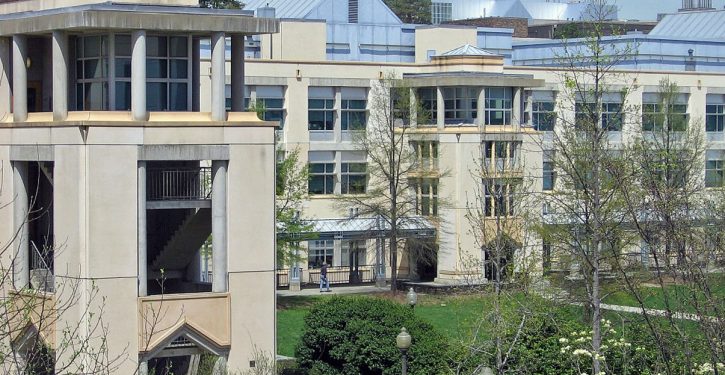
Academic freedom is under assault. Faculty are being told that their research and courses must promote a particular ideology: that racial disparities are due to racism, rather than other causes, such as the voluntary choices made by individuals. The Supreme Court has said that racial disparities are not presumptively due to racism, because reality shows otherwise. Researchers have often found that racial and gender disparities are explained by factors other than prejudice. But at universities across America, such conclusions are now taboo. Faculty are at risk of losing their jobs if their research discloses that something other than racism explains a racial disparity.
Never mind that the highest court in the land has concluded that many racial disparities are not due to racism. In a 6-to-3 ruling, the Supreme Court said that it is “completely unrealistic” to think that in the absence of racism, minorities will be represented in a field “in lockstep proportion to their representation in the local population.” (See Richmond v. J.A. Croson Co. (1989)).
In an 8-to-1 ruling, the Supreme Court emphasized that there is no legal “presumption that people of all races commit all types of crimes” at the same rate, since such a presumption is “contradicted by” real world data showing big differences in crime rates. Thus, racial disparities in arrest or incarceration rates don’t violate the Constitution’s ban on racial discrimination (See United States v. Armstrong (1996)).
Will this presidential election be the most important in American history?
Discussing such realities is now dangerous on campus, as universities around the country impose rules requiring adherence to the ideology of “anti-racism,” and its goal of abolishing “racial disparities.” For example, Duke University says it will revise its curriculum to be anti-racist, require students and staff to take “anti-racism” training, and “mobilize and expand Duke’s research capacity to … reduce racial disparities … in policing, justice, health, housing, education, labor and other domains of life.” Duke aims to transform itself into a global “research leader in anti-racism.”
Princeton faculty recently called for colleagues to be fired for “research” or “publication” that is “racist,” as part of Princeton’s transformation to an “anti-racist institution.”
Antiracism does not mean simply the absence of racism (racism is, of course, a bad thing). Rather, it means the belief that racial disparities are due to racism, and that such disparities justify “discrimination” to “remedy” them. The leading architect of “antiracism” is Ibram X. Kendi, the author of “How to Be an Antiracist.” “When I see racial disparities, I see racism,” says Dr. Kendi, in language trumpeted as if it were a sacred truth by the liberal New York Times. As a law professor notes, “race-neutral criteria are rejected” by Dr. Kendi’s book, which says that “there is no such thing as a not-racist idea,” only “racist ideas and antiracist ideas.”
Judges beg to differ: for example, a federal appeals court ruled in 2001 that a racial “disparity” in discipline rates does not “constitute discrimination,” if a school’s discipline policy is applied in a race-neutral way — even if most suspended students are black.
Many racial disparities obviously are not due to racism: Hispanics live three years longer than whites, on average, even though doctors don’t discriminate in their favor. Asians make more money than whites, on average. And while blacks make less money than whites, on average, African immigrants to America make more money than whites. Racial disparities exist everywhere in society and the world, often for reasons unrelated to racism, notes the black economist Thomas Sowell in his book Discrimination and Disparities. To get rid of racial “disparities,” the government would have to wield totalitarian power, notes black economist Glenn Loury.
But Kendi’s ideology equating racial disparities with racism is now the cornerstone of “anti-racism” at America’s colleges. As part of Cornell University’s anti-racism push, its president recently invited everyone to read “‘How to Be an Antiracist,’ by National Book Award winner Ibram X. Kendi.”
This conception of anti-racism will likely shape Cornell’s new anti-racism mandates imposed on students, faculty, and staff, which include faculty anti-racism training, and:
- The creation and implementation of a for-credit, educational requirement on racism, bias and equity for all Cornell students.
- A systematic review of the curriculum in each of our colleges and schools…
- Amplification of Cornell’s existing scholarship on anti-racism, through the creation of an Anti-Racism Center that further strengthens our research and education on systems and structures that perpetuate racism and inequality, and on policies and interventions that break that cycle.
“Scholarship” rooted in “anti-racism” equates racial disparities with racism and seeks their elimination, regardless of whether they are the product of racist intent. For example, Duke University says it will “mobilize” its “research capacity” to “reduce racial disparities,” as part of its “anti-racism” agenda.
The only way to get rid of racial disparities is to have racial quotas in employment, housing, and arrests. After all, as Duke notes, there are “racial disparities” in “policing, justice, health, housing, education, labor and other domains of life.” As law professor William Jacobson notes, the “key concept” from How to Be an Antiracist is that to remedy racial disparities, you need to engage in new forms of discrimination, such as against whites. As the book explains:
“The only remedy to racist discrimination is antiracist discrimination. The only remedy to past discrimination is present discrimination. The only remedy to present discrimination is future discrimination.”
As “anti-racism” spreads, researchers who question the assumption that a racial disparity is due to racism risk being fired or losing research dollars, in violation of academic freedom. For example, there are racial disparities in police shootings: A higher percentage of the people shot by police are black than one would expect based on their percentage of the population. Is that due to racism, or other factors, such as the higher black crime rate?
Researchers have studied the issue, and some studies — such as one by the black Harvard economist Roland Fryer — have concluded it is not due to racism. (Blacks are actually less likely to be shot while being arrested than whites are). One recent study that questioned whether police shootings are due to racism triggered an enormous backlash from anti-racists, after a conservative cited it in the Wall Street Journal. The backlash led swiftly to the forced resignation of the university vice president who discussed the research, and soon thereafter, to the retraction under pressure of the research itself. Lawyers and law professors have said the study was withdrawn not because of its shortcomings, but rather for political reasons, given the ideological backlash against it. They cited the timing of the retraction, and the shifting reasons given for retracting it.




